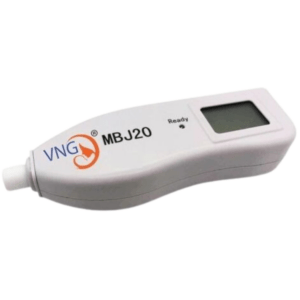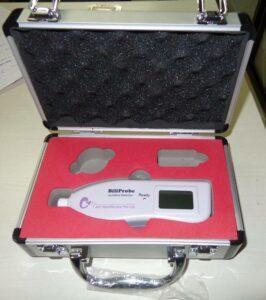In this blog on bilirubinometers which is essential medical device used for diagnosing and monitoring jaundice, we will deep dive into the various types, their working principle and their significance in the accurate assessment and treatment of jaundice.
Bilirubinometers play a crucial role in quantifying bilirubin concentrations, aiding healthcare professionals in making informed decisions regarding patient care. Additionally, we will uncover the clinical applications, benefits, and innovations in bilirubinometer technology. Join us on this insightful journey to enhance your knowledge about bilirubinometers and their contribution to improving patient outcomes.
Understanding Bilirubinometers
Bilirubinometers are invaluable tools in the medical industry for the assessment and management of jaundice. Bilirubinometers provide healthcare professionals with a means to accurately measure bilirubin levels, aiding in the diagnosis and monitoring of this condition. By emitting light onto the skin and measuring the reflected light, the device can calculate the bilirubin concentration. Bilirubinometers provide quick and reliable results, enabling healthcare professionals to make informed decisions regarding treatment and the need for further medical interventions. Overall, bilirubinometers have revolutionized the diagnosis and management of jaundice. With their accuracy and convenience, bilirubinometers have become an essential tool in clinical practice, assisting healthcare professionals in delivering timely and appropriate care for individuals with jaundice.
Exploring Different Types of Bilirubinometers
These devices utilize various technologies and techniques to accurately assess bilirubin concentration. Let’s see the different types of bilirubinometers.
- Transcutaneous Bilirubinometers: They are used to measure bilirubin levels in a non-invasive method. It is done by shining light through the skin. These devices typically utilize a fiberoptic probe that emits light and measures its reflection. By analyzing light absorption, these bilirubinometers estimate the bilirubin concentration in the underlying blood vessels. Transcutaneous bilirubinometers are particularly useful in neonatal care, as they eliminate the need for frequent blood sampling.
- Serum Bilirubinometers: These devices use different techniques to accurately assess bilirubin concentration. Some serum bilirubinometers employ a spectrophotometric approach, where the light of specific wavelengths is passed through the blood sample, and the absorbance is measured. Others go for a direct chemical reaction with bilirubin. By this, we can observe a change in the color that can determine the bilirubin concentration. Serum bilirubinometers are commonly used in clinical settings, providing accurate results for diagnosing and monitoring bilirubin-related conditions.
- Laboratory-based Bilirubinometers: They are sophisticated. They are used in clinical laboratories to analyze blood samples for bilirubin concentration. These devices employ advanced technologies such as high-performance liquid chromatography or automated analyzers. They offer precise and reliable measurements, making them suitable for research, complex diagnostics, and cases requiring highly accurate bilirubin assessments.
- Handheld Bilirubinometers: They are portable. These compact instruments are often battery-powered and have user-friendly interfaces. They are widely used in primary healthcare settings. Handheld bilirubinometers enable healthcare professionals to quickly access the bilirubin levels and help them perform timely treatment decisions
Bilirubinometers come in various types and employ different technologies to measure bilirubin concentration in the blood. Each type has its advantages and applications, catering to different healthcare needs and ensuring efficient management of bilirubin-related conditions.
Unveiling the Working Principle of Bilirubinometers
Bilirubinometers play a crucial role in the diagnosis and monitoring of jaundice, a common condition affecting newborns and adults. Understanding the working principle of these devices helps us appreciate their significance in clinical practice. Bilirubinometers operate based on the principle of spectrophotometry, specifically, the measurement of light absorption. When light passes through the blood sample the bilirubin molecules absorb a specific wavelength of light. As a result of absorbing light, bilirubin concentration increases. Bilirubinometers utilize this relationship to measure bilirubin levels accurately and quickly.
Most modern bilirubinometers employ non-invasive methods, such as transcutaneous or skin bilirubin measurement. These devices emit light at specific wavelengths onto the skin and measure the reflected light using a photodiode or other sensors. Other bilirubinometers may utilize invasive methods, such as direct measurement of bilirubin levels in blood samples. These devices often utilize complex optical systems and advanced algorithms to ensure accurate readings. Understanding the working principle of bilirubinometers is essential for healthcare professionals to interpret the results effectively and make appropriate clinical decisions for patients with jaundice.
Bilirubinometers in Clinical Practice
Bilirubinometers have become indispensable tools in clinical practice, especially in the management of jaundice. These devices provide healthcare professionals with quick and reliable measurements of bilirubin levels, enabling prompt diagnosis and monitoring of patients.
In neonatal care, bilirubinometers are extensively used to assess jaundice in newborns. By non-invasive transcutaneous bilirubinometers, we can measure the bilirubin levels without blood samples. This is particularly beneficial for newborns, as it minimizes discomfort and reduces the risk of infection. Bilirubinometers allow healthcare providers to closely monitor bilirubin levels and make informed decisions regarding the need for intervention, such as phototherapy or exchange transfusion.
In adult medicine, bilirubinometers also play a crucial role. By regularly measuring bilirubin levels, healthcare professionals can assess disease progression, evaluate treatment effectiveness, and make necessary adjustments to medication or therapy. Bilirubinometers streamline the diagnostic process by providing immediate results, allowing for timely intervention, and reducing the need for laboratory testing. These devices have revolutionized the management of jaundice, providing clinicians with valuable information to guide patient care and improve outcomes.
Unlocking the Benefits of Bilirubinometers
Bilirubinometers have revolutionized the diagnosis and management of jaundice in the medical industry. These devices play a crucial role in assessing bilirubin levels noninvasively and accurately, providing numerous benefits for healthcare professionals and patients alike.
- Quick and Convenient Measurements: Bilirubinometers offer rapid and hassle-free measurements, eliminating the need for invasive blood tests. By simply placing the device on the patient’s skin, healthcare providers can obtain readings within seconds, reducing stress and improving patient experience.
- Portability and Versatility: These compact devices are highly portable, allowing healthcare professionals to monitor bilirubin levels in various clinical settings, including hospitals, clinics, and even home healthcare environments. Portability enables timely interventions and prevents complications associated with jaundice.
- Cost-Effectiveness: Bilirubinometers contribute to cost-effectiveness in the healthcare system. By eliminating the need for repeated blood tests, these devices reduce overall healthcare expenses. Additionally, they facilitate early detection and intervention, preventing severe cases of jaundice that may require more extensive treatments and hospitalization.
- Enhanced Workflow Efficiency: Bilirubinometers streamline healthcare workflows by providing quick and accurate measurements. Healthcare providers can make prompt clinical decisions and provide appropriate care based on the obtained readings. This efficiency optimizes resource utilization and minimizes wait times for patients.
- Improved Patient Comfort: Traditional methods of assessing bilirubin levels often involve discomfort and anxiety for infants and their families. Bilirubinometers offer a noninvasive approach, enhancing patient comfort during the evaluation process. This feature is particularly important in neonatal care.
Blirubinometers provide a range of benefits in the diagnosis and management of jaundice. They offer quick and convenient measurements, are highly portable, contribute to cost-effectiveness, enhance workflow efficiency, and improve patient comfort. By unlocking these advantages, bilirubinometers empower healthcare professionals to deliver better care and outcomes for patients with jaundice.
How to Choose the Perfect Bilirubinometer
Selecting the right bilirubinometer is crucial to ensure accurate and reliable measurements, thereby enabling effective management of jaundice. Firstly, accuracy is paramount. Look for a bilirubinometer that has been clinically validated and proven to provide precise measurements. Additionally, consider devices that offer calibration options to maintain accuracy over time.
Ease of use is another crucial factor to consider. Opt for a bilirubinometer that features a user-friendly interface and intuitive operation. Consider devices with built-in prompts or guidelines to ensure consistent and accurate readings. Depending on your specific needs, choose a bilirubinometer that is lightweight and compact for easy transport between different healthcare settings. Look for robust construction and quality materials that can withstand regular use and potential environmental hazards.
Consider the connectivity features of the bilirubinometer as well. Some devices offer data transfer capabilities, allowing seamless integration with electronic health records (EHR) systems or other data management platforms. Cost is another important factor to evaluate. While it is essential to invest in a high-quality bilirubinometer, consider your budget constraints and evaluate the long-term value the device provides. Lastly, seek out customer reviews and feedback from other healthcare professionals who have used the bilirubinometer. Their experiences can provide valuable insights into the device’s reliability, user satisfaction, and overall performance.
Ensuring Accuracy: Bilirubinometer Calibration and Maintenance
To maintain the accuracy and reliability of bilirubinometers, regular calibration, and proper maintenance are essential. These practices ensure that the device continues to provide precise measurements of bilirubin levels, enabling effective management of jaundice in patients. Here are some guidelines to ensure accurate results and prolong the lifespan of bilirubinometers:
- Calibration: Follow the manufacturer’s guidelines for calibration frequency and procedures. Calibration typically involves using calibration standards or known reference samples to adjust the device’s measurement scale.
- Quality control: Implement a quality control program to monitor the performance of the bilirubinometer. This involves periodically testing the device with quality control samples of known bilirubin concentrations.
- Cleaning: Clean the bilirubinometer regularly to remove any dirt, debris, or residue that may affect its accuracy. Follow the manufacturer’s instructions for cleaning procedures and recommended cleaning agents.
- Inspection: Conduct regular inspections to identify any signs of damage or wear. If any issues are detected, contact the manufacturer or authorized service provider for repairs or maintenance.
- Storage: Store the bilirubinometer in a suitable environment to prevent damage or deterioration. Follow the manufacturer’s recommendations regarding temperature, humidity, and storage conditions. Protect the device from extreme temperatures, direct sunlight, and moisture.
- User training: Provide appropriate training to healthcare professionals who will be using the bilirubinometer. Ensure they understand the device’s proper handling, maintenance, and calibration procedures.
- Documentation: Maintain a comprehensive record of calibration, maintenance, and quality control activities. Document the dates of calibration, cleaning, inspections, and any repairs or adjustments made.
By following these guidelines for calibration, maintenance, cleaning, inspection, storage, user training, and documentation, healthcare professionals can ensure the accuracy and reliability of bilirubinometer measurements.
Guidelines for Bilirubinometer Use
When it comes to the use of bilirubinometers in the medical industry, promoting safety is of utmost importance. Bilirubinometers are valuable tools for measuring bilirubin levels in patients, particularly in newborns with jaundice. To ensure accurate and reliable results while safeguarding patient well-being, the following guidelines should be followed
- Calibration and Maintenance: Regular calibration of bilirubinometers is essential to maintain accuracy. Manufacturer’s guidelines should be strictly adhered to for calibration frequency and procedures. Additionally, routine maintenance, including cleaning and servicing, should be performed as recommended.
- Proper Training: Users of bilirubinometers must receive comprehensive training on their operation, maintenance, and safety protocols. This training should cover topics such as correct device handling, appropriate probe placement, and an understanding of measurement procedures to minimize errors and maximize patient safety.
- Hygiene and Infection Control: In healthcare settings, infection control is crucial. Proper hand hygiene should be practiced before and after using a bilirubinometer. It is also essential to clean the device and its accessories between patient use, following strict disinfection protocols to prevent cross-contamination.
- Safety Precautions: Safety methods need to be taken to protect the patient. These may include using disposable probe covers to minimize the risk of infection transmission and ensuring the device is not used on patients with broken skin or open wounds.
- Documentation and Reporting: Accurate and complete documentation of bilirubinometer measurements, including patient information, test results, and any relevant observations, is vital for patient care. Timely reporting of abnormal results to the appropriate healthcare professionals enables timely interventions and prevents complications.
Advancements in Bilirubinometers
In recent years, the medical industry has witnessed significant advancements in the field of bilirubinometers, leading to enhanced management and diagnosis of jaundice. One noteworthy advancement in bilirubinometer technology is the development of transcutaneous bilirubinometers. These devices employ optical sensors to measure bilirubin levels through the skin, eliminating the need for invasive blood sampling. By simply placing the sensor on the baby’s skin, healthcare providers can obtain rapid and reliable bilirubin readings, ensuring prompt intervention when necessary.
Another significant stride in bilirubinometer innovation is the integration of wireless connectivity and cloud-based data management systems. This allows for the seamless integration of bilirubinometer readings into electronic health records, promoting streamlined communication and collaboration between healthcare providers. Real-time data synchronization enables medical professionals to monitor bilirubin levels remotely, facilitating early intervention and reducing the likelihood of complications. Furthermore, cloud-based systems also support data analytics, enabling healthcare organizations to identify patterns and trends in jaundice prevalence, and optimizing preventive measures and resource allocation.
Bilirubinometer (Jaundice) From Leading Indian Manufacturers
Jaundice Detector Transcutaneous- MBJ20
 Presenting the Jaundice Detector Transcutaneous- MBJ20 manufactured by VNG Medical Innovation System Pvt. Ltd. in India. This state-of-the-art device is specifically designed for neonate jaundice detection and dynamic clinical examination. The MBJ20 is a compact and portable transcutaneous bilirubinometer that provides exceptional quality at an affordable price.
Presenting the Jaundice Detector Transcutaneous- MBJ20 manufactured by VNG Medical Innovation System Pvt. Ltd. in India. This state-of-the-art device is specifically designed for neonate jaundice detection and dynamic clinical examination. The MBJ20 is a compact and portable transcutaneous bilirubinometer that provides exceptional quality at an affordable price.
Utilizing advanced technology, the MBJ20 Jaundice Detector accurately determines the transcutaneous concentration of bilirubin, correlating it with serum bilirubin levels. This eliminates the need for painful blood sample collection, ensuring minimal discomfort for newborns. By simply placing the detector on the neonatal skin, healthcare professionals can instantly obtain test results, optimizing efficiency and reducing overall costs.
A key advantage of the MBJ20 Transcutaneous Jaundice Detector is its exceptional suitability for newborns. Its design is meticulously crafted to address the delicate needs of neonates, guaranteeing their utmost comfort and well-being during the jaundice detection process. This device offers a non-contact method of measuring bilirubin levels, eliminating the requirement for invasive procedures and significantly minimizing the risk of complications or infections.
The MBJ20 is remarkably versatile and serves as an invaluable tool for pediatric applications. Its remarkable accuracy and immediate assessment of bilirubin levels make it an ideal solution for monitoring and screening infant jaundice. The handheld design facilitates seamless operation, enabling healthcare professionals to conduct examinations with utmost convenience and efficiency.
Biliprobe Transcutaneous Jaundice Detector
Biliprobe Transcutaneous Jaundice Detector, manufactured by AVI Healthcare Pvt. Ltd., is an exceptional medical device designed to revolutionize the detection and assessment of neonatal jaundice. This handheld instrument offers a non-invasive approach by measuring the transcutaneous concentration of bilirubin, eliminating the discomfort and inconvenience associated with traditional blood draws. With its compact and portable design, the Biliprobe Transcutaneous Jaundice Detector enables healthcare professionals to perform quick and accurate assessments anytime, anywhere. The device features an LCD display for easy reading, a battery indicator to ensure uninterrupted usage, and a convenient self-calibration mechanism for consistent accuracy. By providing instant and reliable results, this innovative bilirubinometer enhances the efficiency of healthcare providers, reduces testing costs, and ultimately improves patient care. Trust in AVI Healthcare’s Biliprobe Transcutaneous Jaundice Detector to deliver precise and convenient neonatal jaundice detection, ensuring the well-being of newborns with efficiency and compassion.
Conclusion
These devices offer non-invasive, rapid, and accurate measurements, aiding in early detection and appropriate treatment decisions. By selecting the right bilirubinometer and ensuring regular calibration and maintenance, healthcare facilities can provide reliable and efficient care to patients with jaundice. Moreover, with the continuous advancements in bilirubinometer technology, such as Medzell‘s futuristic B2B platform promoting Indian medical devices in emerging markets, the future looks promising for improved bilirubin measurement techniques, enabling better patient outcomes and enhanced healthcare practices.



